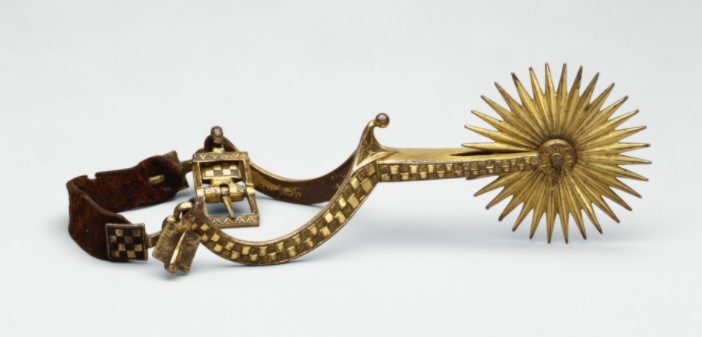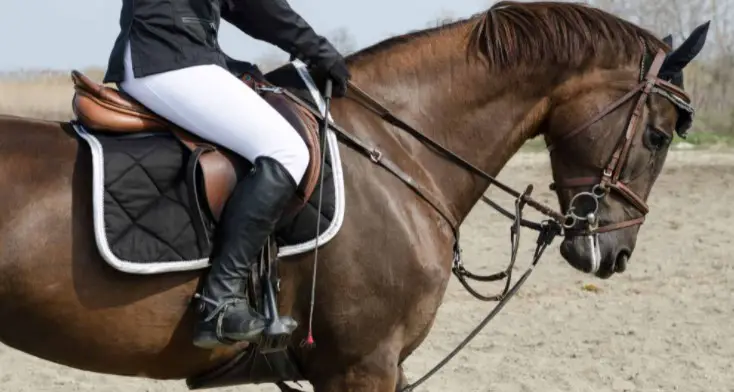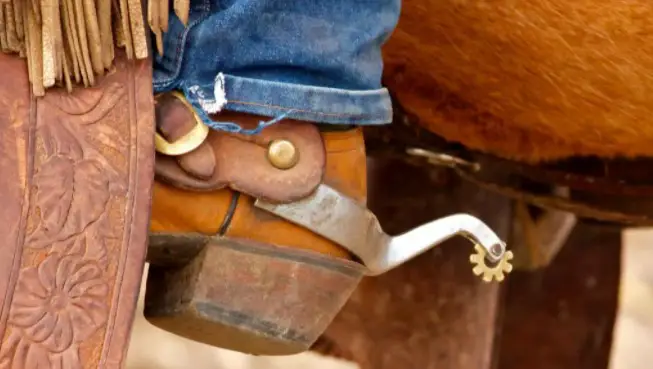Spurs have been a controversial subject in the equestrian world for quite some time. There are different schools of thought regarding whether spurs hurt horses or not. Some claim that spurs do not harm the horses. Others say that it is a good way of communication between the rider and the animal. On the other hand, some horse enthusiasts have gone as far as to say that using spurs on horses is animal abuse.
The correct answer is that there are several factors at work here. The rider and the animal can benefit from the proper use of a spur. As a rule, spurs should not hurt the horses, but sometimes they can. We’ll discuss those factors here but first, let’s see what spurs are!
Spurs: What are They?
Spurs are metal tools that riders wear on the heels of their riding boots. These tools help riders give commands and move the horses in the desired direction. When riders push the spurs into the horses’ sides, the animal should feel some pressure. This pressure signals the horse and can back-up verbal commands. Usually, these signals are very subtle. You shouldn’t even be able to tell that the rider gave a signal from a distance.
A History of Horse Spurs
Spurs weren’t just invented yesterday by someone who wanted to control their horse better. Spurs are old, and by that, we mean they were around even before 300 BC. The first mention of horse spurs that we have found is by Xenophon. After that, there are records of their use by the Celts, the Roman empire, and medieval Arabs. The fact that they are still in use shows their usefulness.

In terms of style, spurs have been evolving as well. Romans tended to use bronze and iron spurs for their horses. The earliest type was the prick spur. The design kept changing, and in the era of Henry III, rowels made their first appearance. The modern spurs favor more blunt ends and are usually metal or plastic in nature.
Horse Spur Design
The basic design of all horse spurs is the same. They consist of a heel band and shank, while some also feature a strap or a rowel.
- Heel Band: This is the part that goes around the heel of your boot. It is there to attach the spur to your boot.
- Shank: This part extends from the heel band and usually touches the horse’s side. It is also called the neck of the spur.
- Strap: The strap is usually there to ensure the spur stays on your boot—most straps are synthetic or leather.
- Rowel: Rowels aren’t necessarily part of every horse spur. A rowel is a rotating wheel or pointy wheel attached to the end of the spur’s shank. Please note that the spiny wheel isn’t sharp. It has blunt or rounded points.
The design can vary according to your style of riding. The shank length and dowel are the main bases for the difference in style.
Do Spurs Hurt Horses?
No, spurs will not hurt the horse if you use them correctly. It should not hurt the horse at all in the first place. However, the animal will get hurt if you use a sharp spur. Using pointed spurs is animal abuse, and most equestrian organizations do not allow their use. You are going to end up paying heavy penalties if you use such a tool and harm the animal. Your sitting position and how you use the spurs will also influence whether it will hurt the horse.

Types of Spurs
There are different types of spurs. Most of these spurs will not hurt the horse as they have a blunt tip. The rider presses this rounded region to the horse’s side. The animal should only feel slight pressure, provided that you are in the correct position.
On the other hand, the spurs with pointed ends are dangerous and can harm the animal. Sharp spurs can scratch or scrape the horses. These types of spurs are illegal. Moreover, its use is considered cruel and constitutes animal abuse. Sometimes they even cause puncture wounds and can draw blood. If this continues, the animal can develop lesions in the injured area. These spurs can also cause the horse to become defensive and start bucking.
Can You Ride Without Spurs?
Yes, some riders even prefer riding without spurs. Riders that do not wear spurs simply press the heels of their boots into the horse’s side. This method is gentler, and experienced riders can do this better due to tons of practice.
Spurs are perfectly safe to use as long as you do it right. Riders tend to stay away from spurs because they think it is harmful to the horse. However, it doesn’t have to be that way.
Do I Need to Use Spurs as a Novice?
Most instructors don’t think that beginners should use spurs. That is a good idea as this method will allow you to train with the horse first. It enables the animal to understand what every command means. Then, you can move on to spurs to better communicate with the horse. If you use these tools on an untrained horse, you will just confuse and annoy the animal. The horse will not know what you mean by the repeated nudges. Who knows, if you can work without spurs for long enough, you might not need the spurs at all!
Other instructors favor using spurs because they make it easier to control the horse. Additionally, remember that you need steady legs to use spurs. If you can’t keep your legs steady, you’ll end up poking the animal a lot. This unnecessary poking can cause the horse to become unresponsive to the command. These mixed signals will lead to confusion. At worst, repeated spur use can hurt the animal and provoke a defensive response. In the end, it is up to you and your instructor.
How to Choose the Correct Spur for Your Horse?
Choosing the right spur is one of the best ways to reduce your horse’s chances of getting hurt. There are several things that you need to consider in that regard.

The first thing you need to take into account is the type of horse you will be riding. Some horses only require a gentle nudge, while others need something more firm. For such horses, you should get spurs that are longer.
The length of your shank is also influenced by how you intend to ride the animal. If you are going to be show jumping, you need a flat style that is not longer than 2.5 cm. It would be best if you got well-fitted spurs that are snug against your heel. That way, you will have an easier time controlling your horse. You should regularly check your spurs for signs of wear. If the spur looks too worn, it could hurt the animal. It is best to change them as soon as possible.
Conclusion
To sum it all up, if you use your horse spurs correctly, you will not hurt your horse. As such, spur usage is not cruel to horses as long as you use the right spur and technique. However, if you use sharp spurs, you will harm the horse. Besides, it is cruel to the poor animal. In addition to that, you need to pay attention to the position of your legs. You can use a good spur and still hurt your horse if you don’t use the proper method.
We recommend learning how to ride your horse without the spurs. That way, you have a better idea of what you are doing. Plus, you are less likely to hurt it. Spurs are good tools for maneuvering the animal. There is no harm in using them as long as you know what to do.
